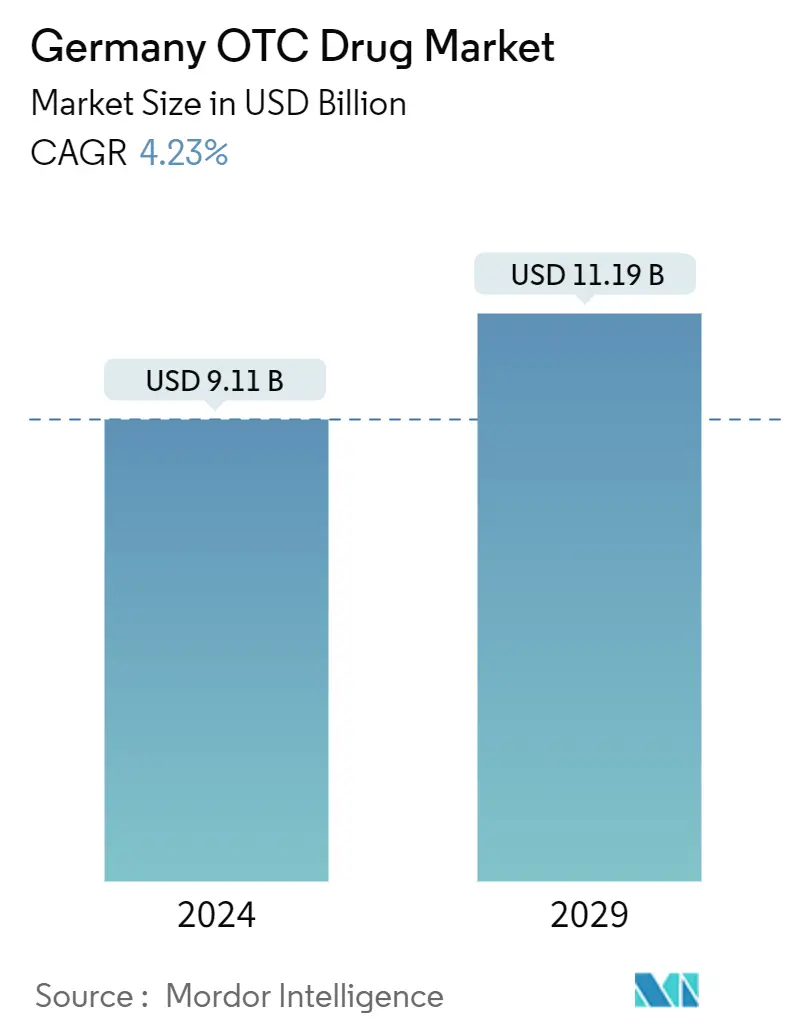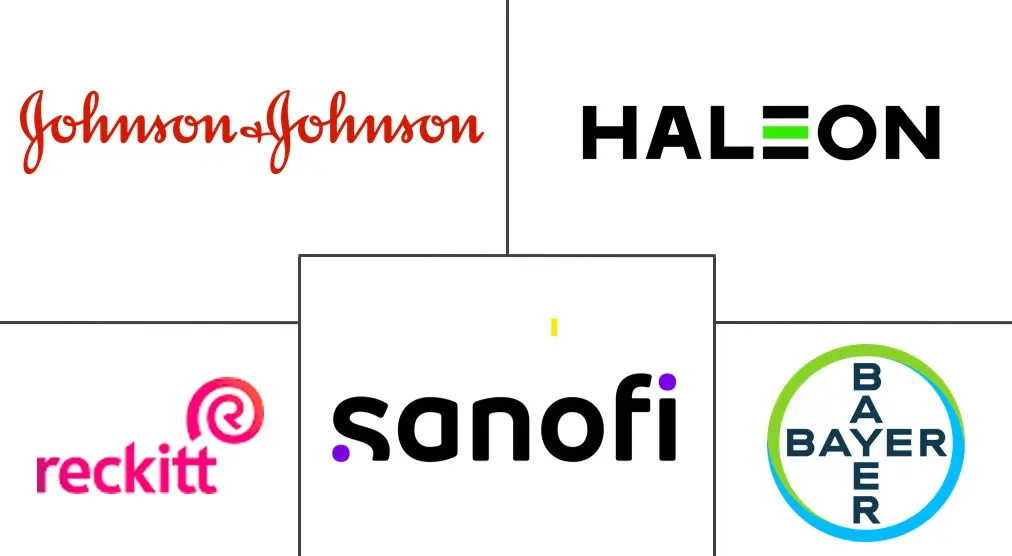Market Size of Germany OTC Drug Industry

| Study Period | 2019-2029 |
| Base Year For Estimation | 2023 |
| Market Size (2024) | USD 9.11 Billion |
| Market Size (2029) | USD 11.19 Billion |
| CAGR (2024 - 2029) | 4.23 % |
| Market Concentration | Medium |
Major Players
*Disclaimer: Major Players sorted in no particular order |
Germany OTC Drug Market Analysis
The Germany OTC Drug Market size is estimated at USD 9.11 billion in 2024, and is expected to reach USD 11.19 billion by 2029, growing at a CAGR of 4.23% during the forecast period (2024-2029).
Amidst the initial phase of the COVID-19 pandemic, over-the-counter (OTC) medicines were in high demand due to limited visits to hospitals and clinics. Due to a lack of medical assistance for general medical ailments, the use of telemedicine among the Germans for self-medication using analgesics, cough, cold, & flu products, vitamin, mineral, and supplement (VMS) products, and dermatology products became increasingly popular as a temporary solution. Therefore, initially, the market growth was impacted due to supply chain disruptions and shortages of drugs owing to the nationwide lockdowns and trade restrictions, and the market is expected to stabilize in the near future.
Furthermore, the major factors propelling the growth of the German OTC drug market include product innovation, expanding distribution channels, pharmaceutical companies' shift from Rx to OTC drugs, and rising self-medication among Germans. Increasing healthcare costs demand better accessibility and affordability of healthcare services. Self-medication with non-prescription drugs has increased in the past years owing to its advantages, such as helping improve the accessibility and cost benefits of healthcare services. Thus, the country witnessed a shift in the trend toward self-medication. For instance, according to the report published by the University of Germany in February 2023, the German population's annual spending on over-the-counter medicines amounts to around EUR 6 billion (USD 6.3 billion). Almost four-fifths of this amount is spent on self-medication drugs. Thus, such factors are likely to boost the adoption of OTC drugs, thereby propelling the market's growth.
In addition, according to the data updated by the Association of the European Self-medication Industry in 2021/2022, non-prescription medicinal products account for one out of every two packages of medicines sold in Germany. The widespread use of over-the-counter medications has been linked to significant cost savings for healthcare providers. As a result, all of these factors above are estimated to increase the demand for OTC products in the country, which is expected to drive the market's growth.
However, incorrect self-diagnosis and the probability of OTC drug abuse may hinder the growth of the market.
Germany OTC Drug Industry Segmentation
As per the scope of this report, over-the-counter (OTC) drugs are referred to as nonprescription drugs. These medicines can be bought by individuals without a doctor’s prescription and are safe for consumption without the doctor’s consent.
The German OTC drug market is segmented by products (cough, cold, and flu products, analgesics, dermatology products, gastrointestinal products, vitamin, mineral, and supplement (VMS) products, weight-loss/dietary products, ophthalmic products, sleeping aids, and other product types) and distribution channels (retail pharmacies, online pharmacies, and other distribution channels).
The report offers the value (in USD) for the above segments.
| By Products | |
| Cough, Cold, and Flu Products | |
| Analgesics | |
| Dermatology Products | |
| Gastrointestinal Products | |
| Vitamin, Mineral, and Supplement (VMS) Products | |
| Weight-loss/Dietary Products | |
| Ophthalmic Products | |
| Sleeping Aids | |
| Other Product Types |
| By Distribution Channels | |
| Retail Pharmacies | |
| Online Pharmacies | |
| Other Distribution Channels |
Germany OTC Drug Market Size Summary
The German OTC drug market is poised for significant growth, driven by several key factors. The initial surge in demand for over-the-counter medicines during the COVID-19 pandemic, due to limited access to healthcare facilities, has set the stage for a sustained increase in market size. The shift towards self-medication, facilitated by the growing popularity of telemedicine and the availability of OTC products like analgesics, cough, cold, and flu remedies, vitamins, minerals, and supplements, has further propelled market expansion. The trend towards self-medication is supported by the rising healthcare costs, which necessitate more accessible and affordable healthcare solutions. This has led to a substantial portion of the population opting for non-prescription drugs, contributing to the market's growth trajectory.
The market is also experiencing a transformation due to product innovation, expanded distribution channels, and a strategic shift by pharmaceutical companies from prescription to OTC drugs. The increasing elderly population, who prefer the convenience of OTC medications for common ailments, is another significant driver. Additionally, the rise of e-pharmacy services, supported by government initiatives, is enhancing accessibility and convenience for consumers. Strategic activities such as acquisitions and collaborations by key players are further strengthening market presence and distribution. Despite challenges like incorrect self-diagnosis and potential drug abuse, the overall outlook for the German OTC drug market remains positive, with expectations of continued growth over the forecast period.
Germany OTC Drug Market Size - Table of Contents
-
1. MARKET DYNAMICS
-
1.1 Market Overview
-
1.2 Market Drivers
-
1.2.1 Inclination of Pharmaceutical Companies to Switch From Rx to OTC Drugs
-
1.2.2 Increasing Self Medication Among the General Population
-
-
1.3 Market Restraints
-
1.3.1 Incorrect Self Diagnosis and High Probability of OTC Drug Abuse
-
-
1.4 Porter's Five Forces Analysis
-
1.4.1 Bargaining Power of Suppliers
-
1.4.2 Bargaining Power of Buyers/Consumers
-
1.4.3 Threat of New Entrants
-
1.4.4 Threat of Substitute Products
-
1.4.5 Intensity of Competitive Rivalry
-
-
-
2. MARKET SEGMENTATION (Market Size by Value – USD)
-
2.1 By Products
-
2.1.1 Cough, Cold, and Flu Products
-
2.1.2 Analgesics
-
2.1.3 Dermatology Products
-
2.1.4 Gastrointestinal Products
-
2.1.5 Vitamin, Mineral, and Supplement (VMS) Products
-
2.1.6 Weight-loss/Dietary Products
-
2.1.7 Ophthalmic Products
-
2.1.8 Sleeping Aids
-
2.1.9 Other Product Types
-
-
2.2 By Distribution Channels
-
2.2.1 Retail Pharmacies
-
2.2.2 Online Pharmacies
-
2.2.3 Other Distribution Channels
-
-
Germany OTC Drug Market Size FAQs
How big is the Germany OTC Drug Market?
The Germany OTC Drug Market size is expected to reach USD 9.11 billion in 2024 and grow at a CAGR of 4.23% to reach USD 11.19 billion by 2029.
What is the current Germany OTC Drug Market size?
In 2024, the Germany OTC Drug Market size is expected to reach USD 9.11 billion.

